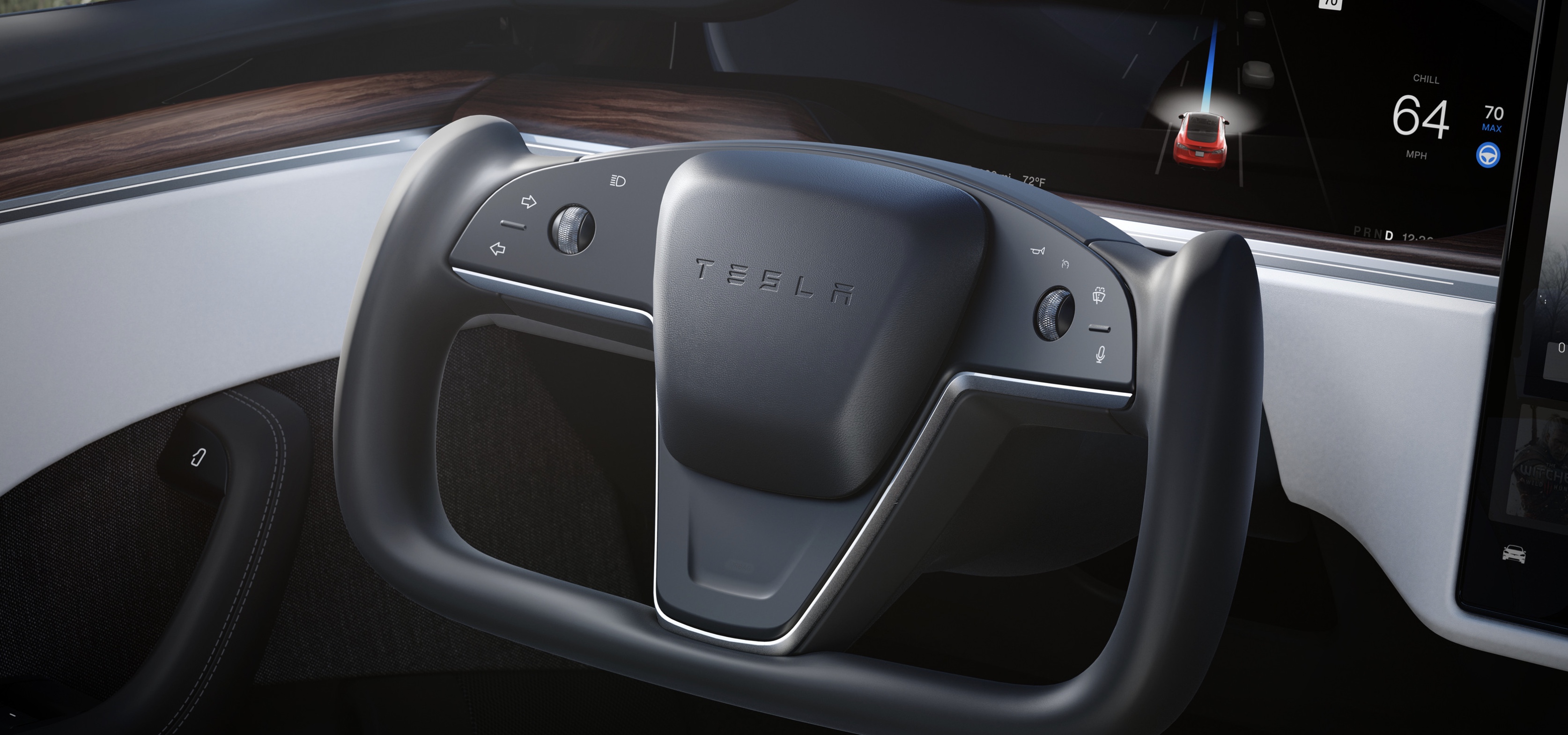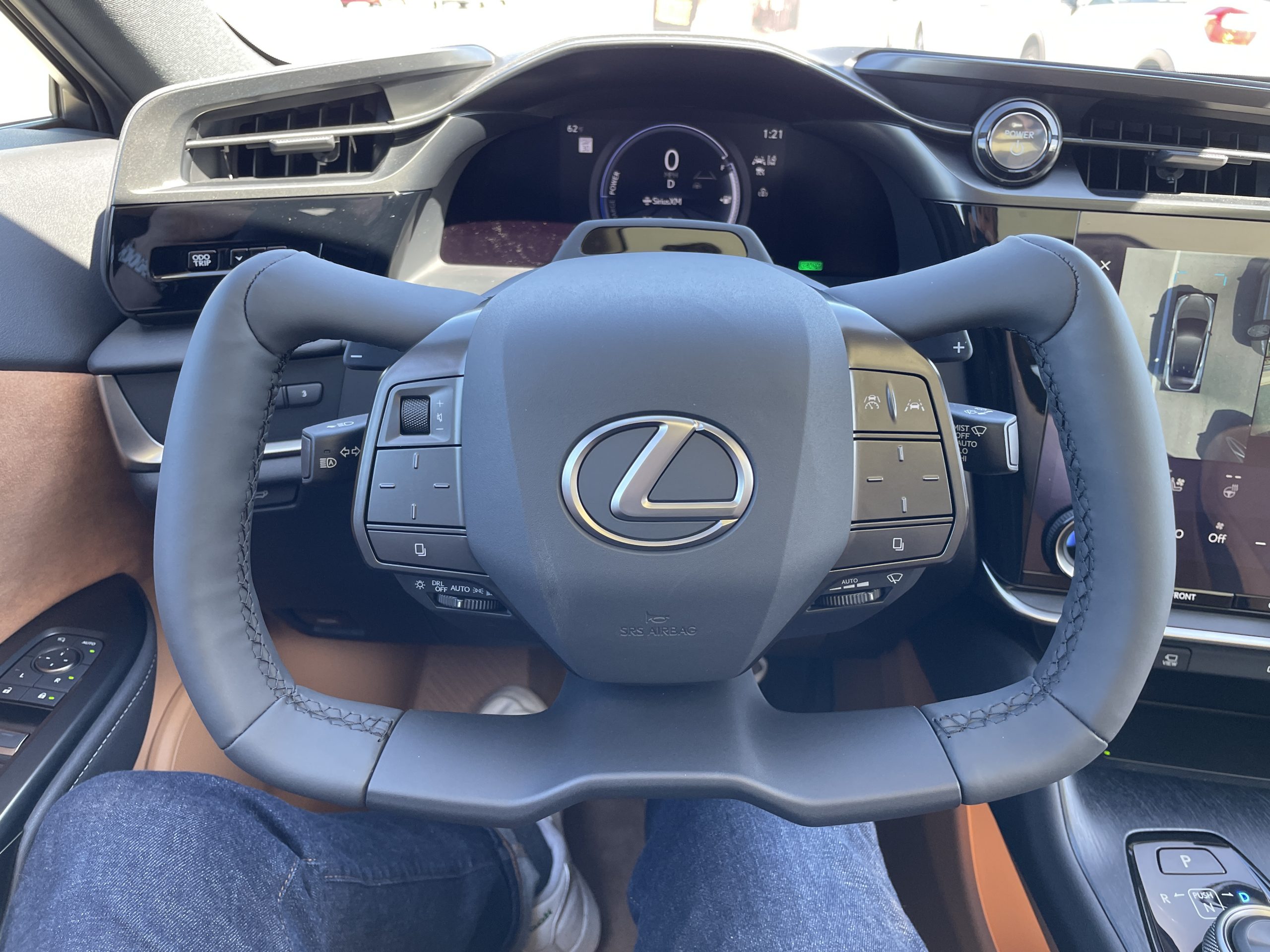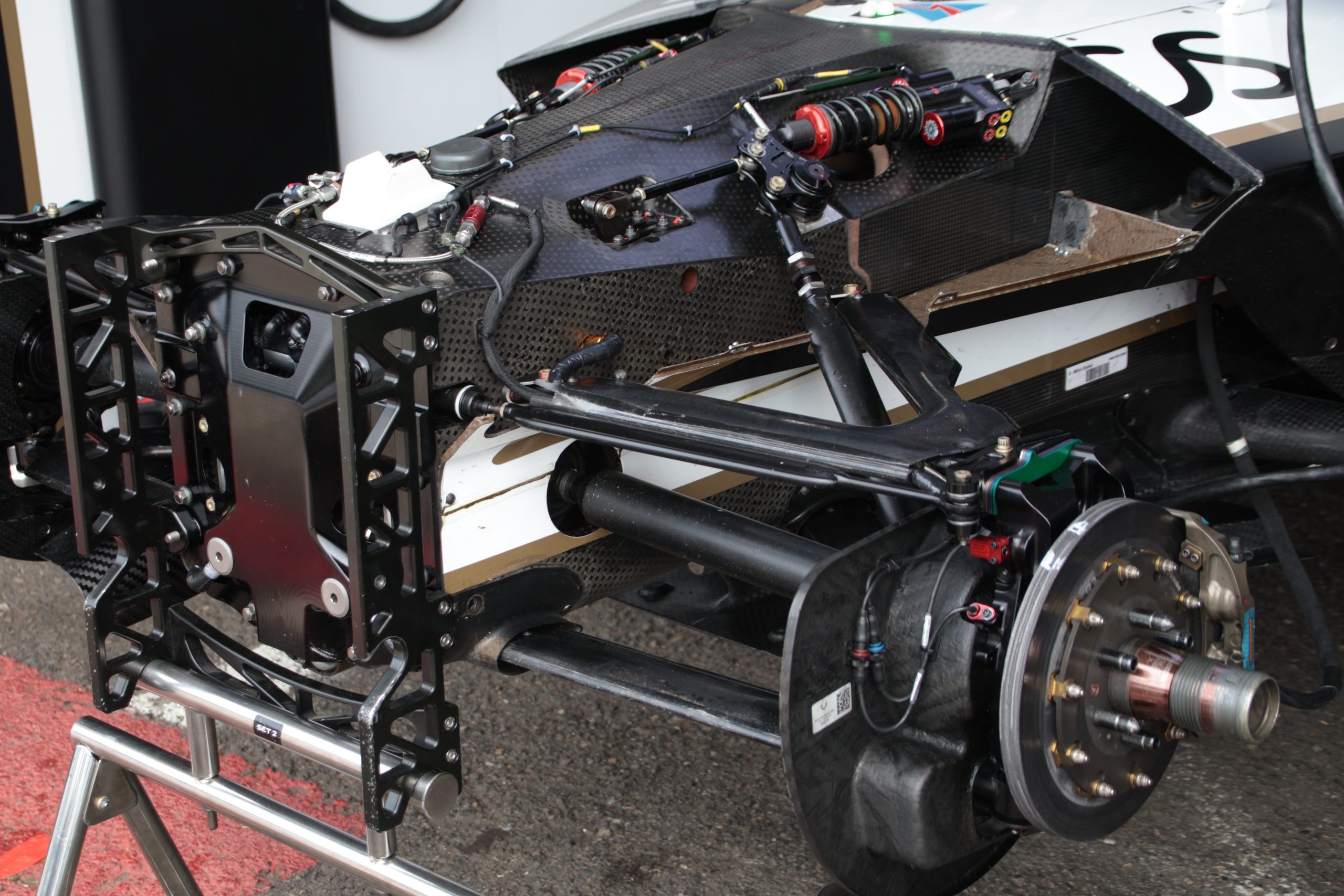First off, the steering mechanism in the new 2023 Lexus RZ is not officially called a “yoke.” The people at Lexus call it that informally, and also because that word is faster than the official name, which is certainly also technically correct: the Steer-by-Wire system. But for all intents and purposes, yes, it’s a yoke—a new and experimental way to control a car in the electrified, increasingly automated era we find ourselves in today.
The yoke makes a somewhat tepid debut on the new Lexus RZ, the first all-electric Lexus and the third member of an EV platform triumvirate that includes the closely related Toyota bZ4X and Subaru Solterra. I say “tepid” because a yoke is an option on the RZ and Lexus is looking to sell just under 5,000 of those cars in the U.S. this year. It’s also not available at the car’s launch and Lexus isn’t yet saying when it will be.
In other words, you’re pretty unlikely to see this thing out there on the road, at least for now.

That may be a good thing. After driving the RZ with the yoke, I can tell you it’s a very promising application of steer-by-wire tech—likely the best I’ve personally experienced—but it definitely takes some getting used to. I also think the RZ was a strange application for this system, but in the end, I wanted to try it some more. Let’s dive into how it works.
Reinventing The Wheel
Perhaps more importantly, we should start with why Lexus included this as an option on the RZ, and why the company bothered developing it at all.
When you really think about it, the steering wheel is one of the few really and truly consistent things we’ve seen on cars over the past century or so. Early horseless carriages had tiller-type controls, but generally, once we went to wheels we never went back. And attempts to literally reinvent the wheel haven’t really gone anywhere. Why would you need to, right? A steering wheel just works.

The idea of a yoke is somewhat marred these days thanks to Tesla. The electric automaker offered a yoke on the Model S and Model X starting in 2021. But amid criticism about its safety (as well as some praise about the extra visibility it offered), Tesla walked that back earlier this year by adding a standard, round wheel as a no-cost option instead. There are now aftermarket options to make it suck less, which speaks volumes.
Also, I am reminded of that time David and our friend and colleague Andrew Collins rented a KITT replica for a Radwood appearance, and they complained about what a nightmare it was to drive the whole time.
But this isn’t Tesla or some novelty custom car builder working with a 1980s Pontiac donor car. This is Lexus—a car company far less apt to want to put its drivers behind the wheel of questionable tech. Can Lexus do better than the yokes we’ve seen so far? (By the way, some critics say that assumption is a form of bias; I say Tesla Autopilot’s safety record speaks for itself.)

It’s actually best to think of what Lexus is doing as two things: the first is the yoke itself, and the second is the thing that underpins it, which is a complex steer-by-wire electronic system. That works thusly: The connection between the yoke and the front wheels is not a mechanical one at all, but an electronic one. When the wheel is turned by the driver, electronic signals are sent to a motor that drives the steering rack, while another motor provides feedback and feel.
Also, the party trick here is that the steering ratio is variable and dependent on speed and conditions; in other words, it behaves differently if you’re parallel parking than it does on a winding backroad. That makes it different from what Tesla did with its yoke. Lexus’ setup is also different from the also-not-mechanical Direct Adaptive Steering used in some Infiniti models, in that its ratios are variable and it does not have a mechanical backup system. It can, however, draw from multiple electricity sources, including its own dedicated battery.
If it were anyone but Toyota here, I’d be slightly worried behind the wheel. Or yoke, I guess.
Can’t Spell Yoke Without ‘Y’, And That’s What I Asked Lexus

At this point you may understand the concept, but also be asking: Why? I know I did. But I understood a little better after talking to Lexus Electrified’s Assistant Chief Engineer, Tatsuya Ishigaki. Besides the obvious benefits to an automaker, like reducing mechanical complexity and thus cost and efficiency, he brought up some cogent points.
For one thing, Lexus’ engineers think the system can provide a more direct steering experience without sacrificing feel, thus making the car more fun to drive.
The second reason is almost the opposite of that: There are a lot of benefits if, or maybe when, cars ultimately go driverless. A steering wheel takes up a lot of real estate. Do you need all of that gone if the car does most of the driving? There are a ton of packaging and room-creating advantages you get if you do it this way.
Also, it’s just cool and new and different, right? I could see at least some RZ buyers opting for this based on the novelty of it alone. But it’s certainly not going to be for everyone.
The Yoke Itself Is Really Nice

Let’s take a moment to appreciate the piece of hardware itself. It’s a compact piece of kit, well-made in the typical Lexus way, and clearly high-quality. I was impressed at how many buttons and functions were compressed onto a unit that’s much smaller than a typical wheel. (One criticism: the turn signal and wiper stalk are stubbier than usual, so I missed them a lot when I had to use them.)
The volume switch is now a roller knob and lighting and wiper intensity are controlled by little sliders. Controls for intelligent cruise and automated driving assistance are on a small button as well, and there’s a kind of selector pad for fishing through menus.
Also, it’s not just the wheel that’s different here. Opting for the steer-by-wire system gets you a different dashboard, a lower one for more windshield real estate and a better view of the road. It’s all pretty well-thought-out.
But none of that matters if it can’t deliver on the road.
How Does It Drive?
The nice people at Lexus insisted I learn the ropes on a closed parking lot course before hitting public streets. Safety first, and all that. I’m glad they did. This thing does come with a learning curve, albeit not an insurmountable one.
It took me about five laps around the traffic-cone course they set up (more like your high-school driving exam than an autocross course) before I really got the hang of things. The biggest problem for me was 20+ years of muscle memory becoming suddenly irrelevant; I was constantly reaching for portions of the steering wheel that weren’t there when I was executing turns on the course.

You see, control isn’t the problem; that would be just getting used to how different it all is. Because it really is a variable steering system based on vehicle speed and user input, you don’t need to turn the yoke all the way in a certain direction like you would on a normal car. But your mind tells you to, because you’re used to it. This led to some awkward maneuvers for me, including the death of at least one cone.
I sincerely apologize for this. I hope that cone didn’t have a family.
The steer-by-wire system is much more sensitive and much more direct than a normal setup. Smaller inputs go a much longer way. There’s no need for the hand-over-hand turning here. But I got the hang of it, more or less, eventually. I actually asked for extra laps just to make sure I felt good about what I was doing on a public road.
But that’s where the yoke shined the most for me. I actually found it easier to operate on the street than around a small parking lot. That’s when the system’s speed-sensitive variable abilities shine most. You really do not have to turn it as much as you would a wheel to get the same result.
Amazingly, the feel is actually pretty good here too, if you can believe it. It’s different, since it’s a motor transmitting the sensations of steering feel based on data inputs, but it works. It didn’t feel totally numb, like some video game. I half-expected that. This system feels programmed for enthusiastic driving.

Out on the road, it felt more like I was piloting the RZ than driving it. I texted a photo of the yoke to my father, and he cracked that I was channeling my inner Lewis Hamilton. He’s not entirely wrong. It’s like you’re an F1 driver with this thing, a mech pilot. And the tight, highly responsive nature of the system reinforces that feeling. It’s a more sporting experience than I ever expected, and it works well.
In fact, that’s one area where the whole deal felt kind of incongruent. The steer-by-wire system and yoke feel like they would both be more at home on a sports car or a sport sedan; maybe that new Lexus Electrified Sport Coupe Concept if that went to production. As it is, an RZ is a soft, cushy, low-intensity car, not unlike your mom’s RX crossover. The yoke and steer-by-wire system are remarkably capable. They feel out of place on a car like this.
I still had more trouble with the yoke itself at lower speeds and parking, as Motor Trend seemed to last year as well:
The only time Steer-by-Wire feels awkward is when you approach full lock: The RZ cranks in a lot of steering angle in the yoke’s last few degrees of travel, and it feels odd to have the steering ratio change so rapidly. It’s an oddity we can live with, though, especially considering you really only need full steering angle at very low speeds—and it beat the daylights out of all the arm-twirling required in the RZ with a conventional wheel (or Tesla’s Model S with its ill-conceived yoke).
I’d agree with all of that, and I independently came to the same conclusion they did. I’d love to try steer-by-wire with an actual steering wheel. The system’s simplicity, feedback, directness and capability feel like they could make it into wider production, while Infiniti’s system kind of died on the vine and nobody misses it much. There may well be a future for this sort of thing. But I, too, am not sold on the yoke.
I want to try it more to see if I can come around.
Should You Buy It?
The RZ isn’t going to be some Tesla Model Y-killing volume car, obviously. It’s Lexus dipping its toes into the BEV arena that it claims will be its future soon. It’s also intended for the Lexus faithful and might be that family’s second or third car. With just 220 miles of range, it seems unlikely to be someone’s main ride. The RZ is a kind of country-club-and-grocery-store EV. The real stuff comes later, when Lexus goes all-EV by 2030.

All of this is to say I could see some RZ buyers checking this box for the novelty of it. If it’s an EV they don’t drive all the time and are the early adopter types who want to impress their kids and friends, they should go for it. It’s fun! It’s something different, and it’s probably the best application we’ve seen so far of these two technologies, showing that both of them have promise for the future.
Maybe on a fast, powerful and sleek electric coupe? I’m willing to sign up for test-driving duties, Lexus.
Support our mission of championing car culture by becoming an Official Autopian Member.








Yeah, we’ve reduced easy to repair (and let’s face it – how often does the steering system need repair to the linkage between the wheel and the rack) mechanical complexity and replaced it with difficult to repair electronic complexity that requires redundant systems. That sounds like a great idea.
Maybe I’d quickly regret it, but I think I’d like one of these with a Brodie knob on it.
Eh. Just put a wheel on it.
Perhaps I’m having a low reading comprehension day, but…
Is it the yoke or the steer-by-wire system that’s being tested for driverless cars? Or both? I conjecture that the yoke could possibly retract into the dash for full autonomous mode, and that is what is being looked at here? -hence the stubby stalks?
ohhhh rich old people are going to crash around parking lots with this like bumper cars at the fair.
The steer by wire is only interesting if you can get it without the stupid hardware accessory. There is nothing about a yoke or yoke-like device that belongs in a road car. Dragsters? Sure. Formula 1? OK.
City driving requires unexpected movements, and having part of the wheel gone missing will make that much less safe. Long drives require different places to hold the wheel to avoid excess fatigue, and not having 360 degrees of options makes them much less safe. And if you hit a road hazard or have a malfunction, you definitely don’t want to catch air while grasping for the steering control!
Only idiots and attention whores would choose this option for a road car. Elon tried to make it mandatory…
Canoo supposedly has approval for their steer by wire system. One of their representatives said so in a TFL-EV video posted last week. ( https://youtu.be/KgAghyLo4os )
It looks like both companies use similar variable ratio logic. I imagine steering these is like learning how to drive an EV via one pedal. Weird at first then it becomes natural.
Steering and brakes are the two systems that absolutely in no way need to be missing mechanical, physical backups as a MINIMUM. I personally would not buy a car where the wheel (take your yoke and shove it) isn’t physically connected to the steering.
Well I guess the “yolk” is on me. I’m way to “chicken” and probably would be all “yoked up” having this steering system in my “hatch”. Somebody would have to do a lot of “egg-splaining” before I “chick” this box.
I want a joystick. My lonely high school years gave me plenty of practice with that
Just say NO! to steer-by-wire systems
How exactly is it legal in America without a mechanical backup? I’m still very confused by that.
And to follow that up, how difficult is this system going to be to perform alignments on?
I figure you set the alignment, then go into diagnostics and zero the yoke to center the steering. Probably something to be done at the dealership. Probably has at least 2 redundant channels that can source from both the battery pack or the 12 volt mini battery if things go wrong, so you can get it to the side of the road. Airplanes have both redundant flight control systems and control surface actuators.
https://aviation.stackexchange.com/questions/21744/how-do-redundancies-work-in-aircraft-systems
It does have a backup, it’s just that the backup is another redundant steer-by-wire system. I’m not too worried about it, I mean if you’ve ever flown in an airliner you’ve trusted your life to steer-by-wire systems already. There’s no reason they have to be failure-prone, although given how utterly crap automakers tend to be at anything software-related, maybe there’s more cause for concern than might otherwise be warranted.
Poor Lexus salespeople – they’re probably in for some pretty scary test drives over the next few years.
It does beg the question of how they’re going to get ‘normal’ people used to this – you drive different cars all the time, and still felt like you needed several laps around a pre-programmed course to get the hang of it. I guess at the dealer, it’ll be ‘circle the building a few times and hope for the best’?
How does it cope with applying opposite lock to maintain oversteer?
With conventional steering you can let the wheel spin through your fingers as the back end breaks away and catch it at the balance point to hold your slide angle. You do a similar thing to straighten up or transition to a slide in the opposite direction.
Does this system let you drift?
I mean the steer-by-wire. Obviously the yoke is garbage for this.
These are the important questions and I’m glad someone is brave enough to ask them.
What else are old competitive drifters good for?
It’s asking niche questions on the internet or smashing up whatever the current cheapest RWD car is.
The wheel gives feedback, just like video game wheels that allow the same functionality you mentioned. And those wheels don’t have Lexus engineering behind them.
I’ve not used a current tech video game steering wheel, but all the ones I have tried have been terrible for castor-induced self-applied opposite lock.
Before ESP you could jump in a car and drive it to your level of skill. Then ESP came in and if you applied opposite lock to correct oversteer some systems would instead decide you were turning a corner, and unpredictable weird shit would happen. So you had to un-learn a level of skill, or turn the ESP off. Good ESP systems now make you feel like you have god-like skill without you realising they are helping.
I’m wondering if this new technology is going to work with existing skills or make us all the same level of sort-of-OK-at-steering-a-car.
All of the good stuff here seems to come from the steer-by-wire system, and it all boils down to variable steering ratios. Also I guess the steering feel is less dead than expected, which is pretty faint praise. There’s absolutely nothing about that which requires a yoke—it would work just as well with a wheel.
I don’t buy either of Lexus’s rationales for the yoke. A yoke is demonstrably not necessary for a direct and engaging driving experience, and while abbreviated physical controls may be advantageous in autonomous cars, the RZ is not one of them and therefore does not reap that benefit.
The whole thing is kind of embarrassing.
My thoughts exactly. The only thing mentioned in the article that is at all an argument in favor of the yoke is the visibility with the lower dashboard, but I’m just not convinced that’s a big enough problem to justify an input mechanism that requires seasoned drivers to take laps around a closed course to get comfortable with it before driving on public roads.
Even if this is a very well executed version of the yoke, I still feel like it’s going to be infuriating to use for most people and the whole variable ratio thing is ripe for tuning issues, and given how often automakers mess up the steering on cars I don’t have a lot of faith that it won’t be a complete shit-show.
I’ll give Lexus/Toyota points for coming up with a workable system. Most engineering advancements have a ‘WTF’ phase when they first come out… Whether they make the car weird to drive (ABS or stability control being too aggressive), or failure prone (Displacement on Demand still prone to failure points after all these years).
I don’t know which site had it, but there was a good write-up about how the variable rate steering yoke is implemented on the Busy Forks vs the Tesla. Tesla didn’t do the work and just slapped on a yoke-shaped steering wheel versus a steering yoke.
A variable steering ratio is the one example I can see of a yoke not immediately being a stupid idea. However, as you have pointed out, you have to throw out all of your muscle memory and intuition as it comes to certain maneuvers. Probably a short learning curve, but certainly could throw some people for a loop.
I would imagine it’s similar to the “Enhance pointer precision” option on your mouse settings. It changes how far the mouse moves based off of speed. Turn that on or off and your mouse will feel unusable for like 5 minutes, and then you’re completely adjusted.
A short learning curve is fine if all your attention is going to be focused on what you’ve learned. Or a journalist focused on how this car is different.
Formula 1 cars can use yokes because of the intense concentration involved in driving.
Formula 1 races are nothing like taking the family on a weekend road trip.
If you hit a pothole while reaching for the radio while out on a Sunday drive, there’s no way a yoke is as safe and predictable as a wheel. It’s a stupid solution in search of a problem. Even the squircular wheel of the latest Corvette is a compromise I would barely tolerate in daily driving.